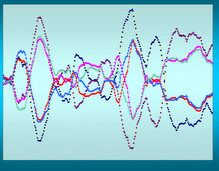That is one of the reasons why I like using indicators such as a declining MACD as a "finding" method and then switching to using candlestick price action such as the BOB to inform my buy decision. It is also the reason why I prefer exponential moving averages - they are closer to reality than any other kind of moving average.
The Cross Over method is another trader's observation - not quite technical analysis but close enough to be confused for it. You will find cross overs on every time frame and what they signify is a vector change in the stock. A vector consists of both direction and magnitude and the cross over is generally accompanied by a reversal of course and a quickening of price (increasing volatility).
When the cross over is up, as is shown in the following chart of NI -

it can presage an extremely profitable buying opportunity.
The cross over can also be employed on the short side.
The rules are simple - for a buy the day opens below the EMA bundle (4, 8 and 21) and closes above the EMA bundle. This is shown on 3/15 on the chart above. You can buy on the open or close the next day and set your stop below the cross over candle's low.
Exiting a trade is always a personal preference - maybe you only want to hold it for a couple of days, maybe you want to hold until the EMA's start bunching again. You can see where that begins to happen around 4/12 or so. I personally find that candle at 4/03 - one that I term the "cathedral of dead money" (especially after that long white "blow off top" on 4/02) - is an indicator of the end of the run.
As I say there are many ways to find an exit - there are only a few to find an entry and cross over is one of them. Remember it isn't "high" and "low" but "open" and "close" - the body of the candle must bisect the bundle.
Simple methods = good profits.

No comments:
Post a Comment